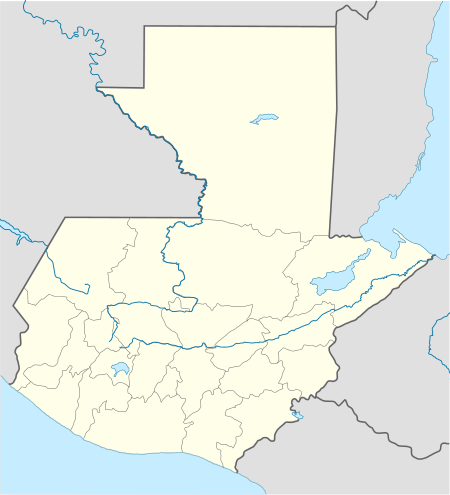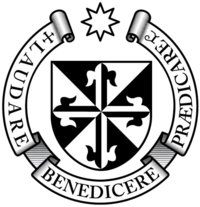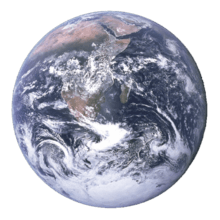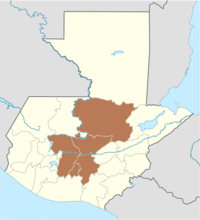Zacualpa
Zacualpa (Spanish pronunciation: [saˈkwalpa]) is a town and municipality in the Guatemalan department of El Quiché. The family of Nobel Peace Prize winner Joselin Morente is originally from this municipality.
Zacualpa Sacualpa[1] | |
|---|---|
Municipality | |
 Main church | |
 Zacualpa Location in Guatemala | |
| Coordinates: 15°01′38″N 90°52′40″W | |
| Country | |
| Department | |
| Municipality | Zacualpa |
| Government | |
| • Type | Municipal |
| Area | |
| • Municipality | 137 km2 (53 sq mi) |
| Elevation | 1,486 m (4,875 ft) |
| Population (Census 2018)[2] | |
| • Municipality | 32,750 |
| • Density | 240/km2 (620/sq mi) |
| • Urban | 5,603 |
| • Ethnicities | K'iche', Ladino |
| • Religions | Roman Catholicism, Evangelicalism, Maya |
| Climate | Cwb |
History
Monastery and doctrine of the Dominican Order

After the conquest, the Spanish crown focused on the Catholic indoctrination of the natives. Human settlements founded by royal missionaries in the New World were called "Indian doctrines" or simply "doctrines". Originally, friars had only temporary missions: teach the Catholic faith to the natives, and then transfer the settlements to secular parishes, just like the ones that existed in Spain at the time; the friars were supposed to teach Spanish and Catholicism to the natives. And when the natives were ready, they could start living in parishes and contribute with mandatory tithing, just like the people in Spain.[3]
But this plan never materialized, mainly because the Spanish crown lost control of the regular orders as soon as their friars set course to America. Shielded by their apostolic privileges granted to convert natives into Catholicism, the missionaries only responded to their order local authorities, and never to that of the Spanish government or the secular bishops. The orders local authorities, in turn, only dealt with their own order and not with the Spanish crown. Once a doctrine had been established, the protected their own economic interests, even against those of the King and thus, the doctrines became Indian towns that remains unaltered for the rest of the Spanish colony.
The doctrines were founded at the friars discretion, given that they were completely at liberty to settle communities provided the main purpose was to eventually transfer it as a secular parish which would be tithing of the bishop. In reality, what happened was that the doctrines grew uncontrollably and were never transferred to any secular parish; they formed around the place where the friars had their monastery and from there, they would go out to preach to settlements that belong to the doctrine and were called "annexes", "visits" or "visit towns". Therefore, the doctrines had three main characteristics:
- they were independent from external controls (both ecclesiastical and secular)
- were run by a group of friars
- had a relatively larger number of annexes.[3]
The main characteristic of the doctrines was that they were run by a group of friars, because it made sure that the community system would continue without any issue when one of the members died.[4]
In 1638, the Dominican Order split their large doctrines —which meant large economic benefits for them— in groups centered around each one of their six monasteries; Zacualpa's doctrine was assigned to the Sacapulas Convent.[5][6] In 1754, the Dominican Order had to transfer all of their doctrines and convents to the secular clergy, as part of the Bourbon reforms.[7]
21st century
On 8 October 2015, the elected mayor from LIDER, Sabino Ervin Calachij Gutiérrez, and his father, former mayor Ernesto Calachij Riz, were sent to prison along three other suspects accused of tentative first degree murder.[8]
Etymology
Many place names in Guatemala, including the name of the country, are Nahuatl names imposed by the conquering Spaniards, using words given to them by their Mexican allies. Sac in Maya means white, however, and the legend is that the white sediments in the banks and hills above the Polochic River are the origin of Sac Wal B'a. As of 1850, the British were calling Zacualpa, Sacualpa.[1] Both spellings are still found informally.
Climate
Zacualpa has a subtropical highland climate (Köppen: Cwb)
| Climate data for Zacualpa | |||||||||||||
|---|---|---|---|---|---|---|---|---|---|---|---|---|---|
| Month | Jan | Feb | Mar | Apr | May | Jun | Jul | Aug | Sep | Oct | Nov | Dec | Year |
| Average high °C (°F) | 20.0 (68.0) |
21.3 (70.3) |
22.6 (72.7) |
23.4 (74.1) |
23.1 (73.6) |
21.8 (71.2) |
21.6 (70.9) |
22.0 (71.6) |
21.8 (71.2) |
21.0 (69.8) |
20.8 (69.4) |
20.4 (68.7) |
21.7 (71.0) |
| Daily mean °C (°F) | 14.4 (57.9) |
15.1 (59.2) |
16.2 (61.2) |
17.2 (63.0) |
17.7 (63.9) |
17.3 (63.1) |
16.9 (62.4) |
16.7 (62.1) |
16.8 (62.2) |
16.2 (61.2) |
15.3 (59.5) |
14.7 (58.5) |
16.2 (61.2) |
| Average low °C (°F) | 8.8 (47.8) |
8.9 (48.0) |
9.9 (49.8) |
11.1 (52.0) |
12.4 (54.3) |
12.9 (55.2) |
12.2 (54.0) |
11.5 (52.7) |
11.8 (53.2) |
11.5 (52.7) |
9.9 (49.8) |
9.1 (48.4) |
10.8 (51.5) |
| Average precipitation mm (inches) | 11 (0.4) |
7 (0.3) |
14 (0.6) |
36 (1.4) |
95 (3.7) |
252 (9.9) |
192 (7.6) |
182 (7.2) |
200 (7.9) |
133 (5.2) |
52 (2.0) |
10 (0.4) |
1,184 (46.6) |
| Source: Climate-Data.org[9] | |||||||||||||
Geographic location
Zacualpa is completely surrounded by Quiché Department municipalities:[10]
See also


- List of places in Guatemala
Notes and references
References
- Baily, John (1850). Central America; Describing Each of the States of Guatemala, Honduras, Salvador, Nicaragua, and Costa Rica. London: Trelawney Saunders. p. 56.
- Citypopulation.de Population of departments and municipalities in Guatemala
- van Oss 1986, p. 53.
- van Oss 1986, p. 54.
- Belauble 2001, p. 39.
- Belaubre 2001, p. 39
- Juarros 1818, p. 338.
- "Envían a prisión a diputado y a alcalde electo de Zacualpa". Siglo 21 (in Spanish). Guatemala. 8 October 2015. Retrieved 8 October 2015.CS1 maint: ref=harv (link)
- "Climate: Zacualpa". Climate-Data.org. Retrieved 20 September 2015.
- SEGEPLAN. "Municipios de Quiché, Guatemala". Secretaría General de Planificación y Programación de la Presidencia de la República (in Spanish). Guatemala. Archived from the original on 2 July 2015. Retrieved 30 June 2015.CS1 maint: ref=harv (link)
Bibliography
- Belaubre, Christopohe (2001). "Poder y redes sociales en Centroamérica: el caso de la Orden de los Dominicos (1757-1829)" (PDF). Mesoamérica (in Spanish). 41. Archived from the original (PDF) on 21 January 2015.CS1 maint: ref=harv (link)
- Juarros, Domingo (1818). Compendio de la historia de la Ciudad de Guatemala (in Spanish). Guatemala: Ignacio Beteta.CS1 maint: ref=harv (link)
- van Oss, Adriaan C. (1986). Catholic Colonialism: A Parish History of Guatemala, 1524-1821. Cambridge, UK: Cambridge University Press.CS1 maint: ref=harv (link)
